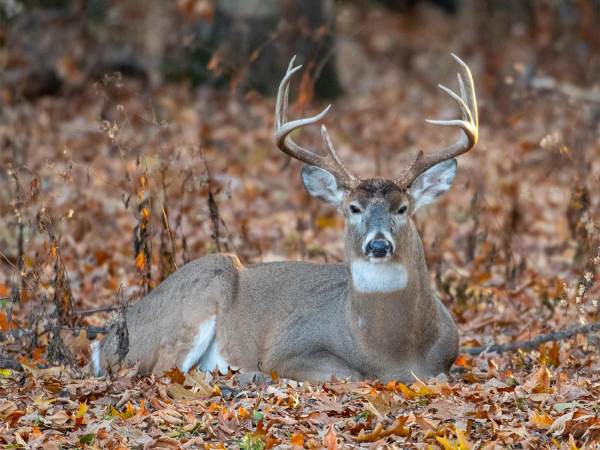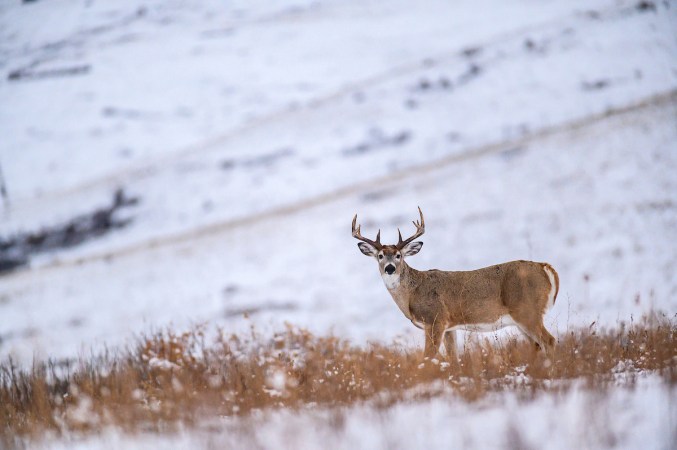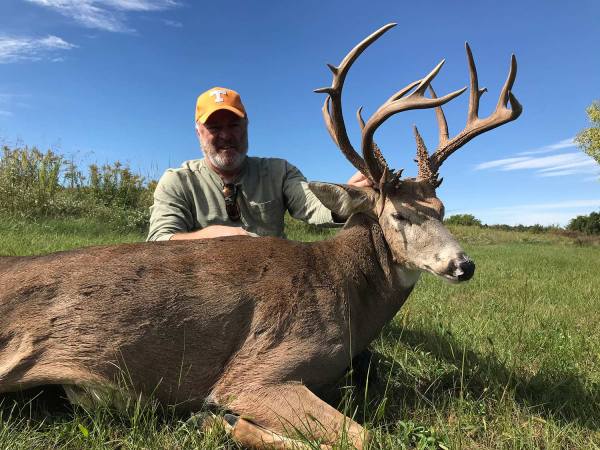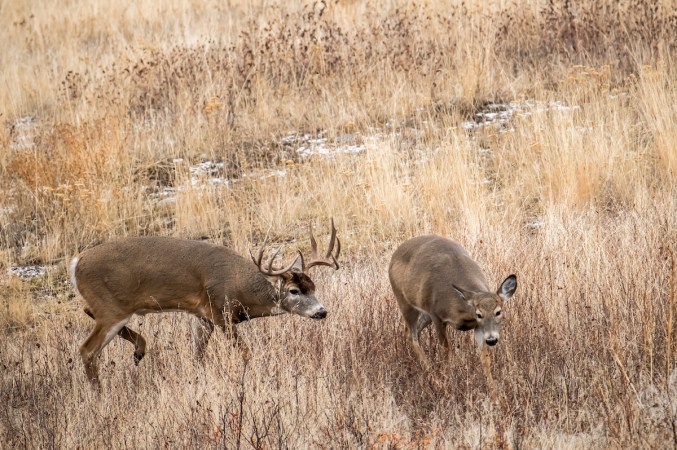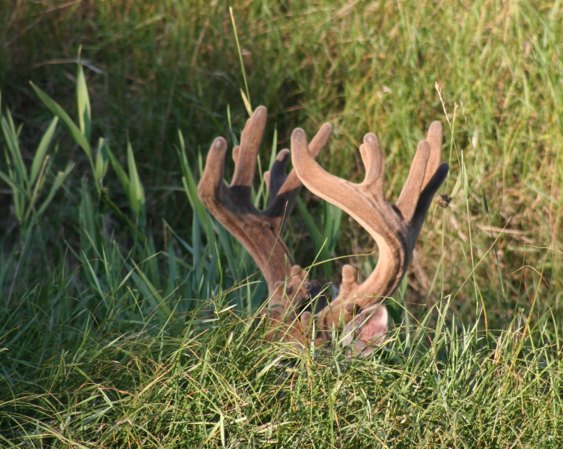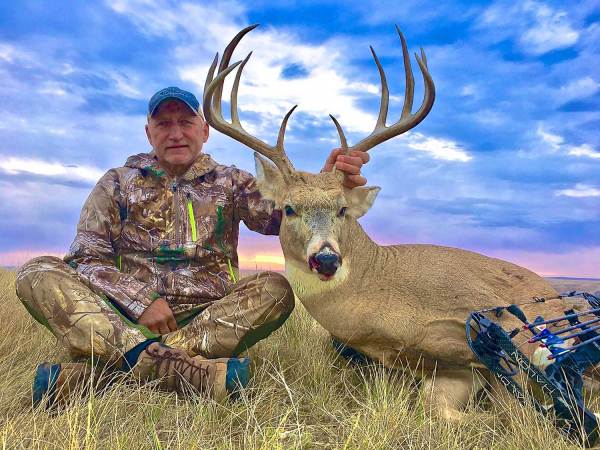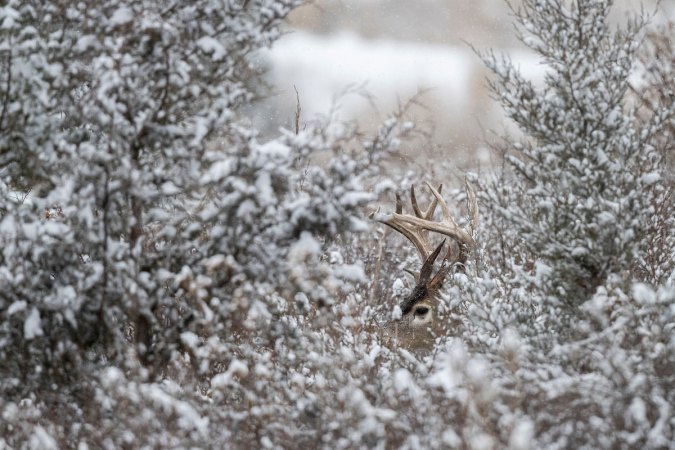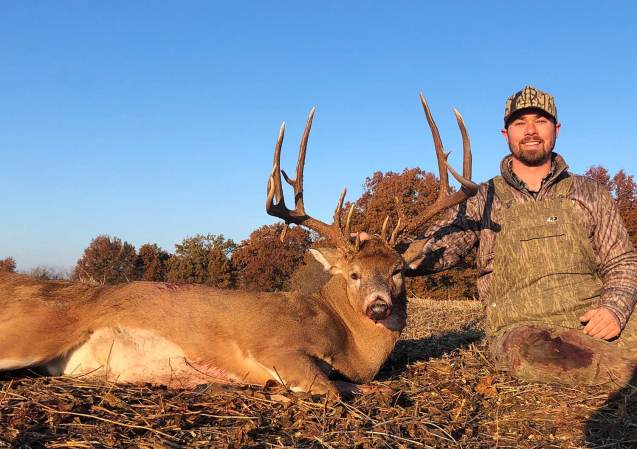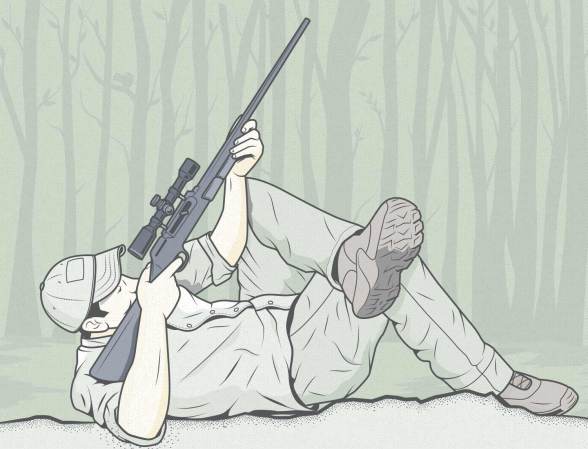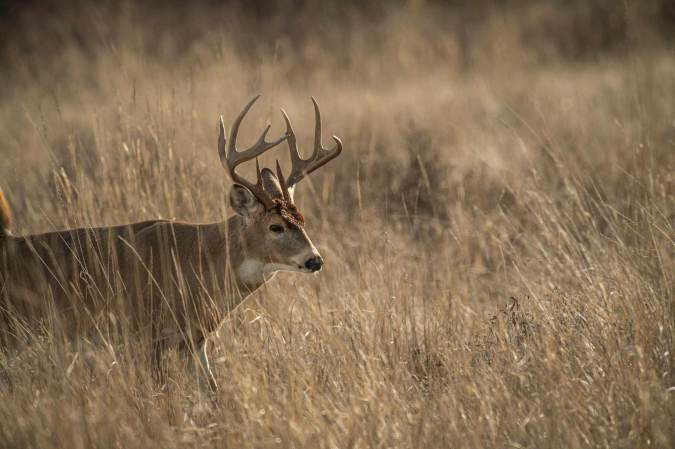One late summer day a few years ago, Kevin Jaegers set out a few trail cameras on his father-in-law’s farm in Missouri. When he checked his cams a few weeks later he about fainted—several images of a 200-class monster with massive drop tines! He hung a tree stand and vowed to hunt the giant hard in September.
That was a departure for Jaegers, who normally doesn’t hunt much in the early bow season. “But I figured that if I was ever going to see the buck, the first days would be best,” he says. “After that, pressure all around would likely turn him nocturnal.”
On September 15, opening day, the wind was wrong for Jaeger’s stand. “I tried to talk myself out of going that evening because the breeze was blowing where I thought deer would bed and travel,” he says. But Jaegers knew the giant was out there, and so he went.
With the leaves thick on the trees, Jaegers couldn’t see far in the green woods. He spotted a few does close, and then an 8-pointer. “I looked behind him and there he was, I saw those drop tines!” says Jaegers.
The beast walked behind a tree, and Jaegers drew his bow. His arrow was true, and the trail cam images didn’t lie. The rack grossed 201 and netted 194 5/8. “I can’t believe I was in the right place at the right time on opening day,” Jaegers says.
Well, believe it. The first days of your bow season in September (or early October in some states) are second only to the rut for the best time to kill a big deer. Bucks have not been pressured for months; they’re living in small home ranges; and they’re walking predictable bed-to-feed patterns. You might not whack a 200-class titan like Jaegers did, but a mature 8- or 10-pointer might be in the cards if you hunt smart. Try this plan.
Read Next: The Best New Bowhunting Gear for 2019
Step 1: Know Where September Bucks Live and Travel
New science reaffirms that the late-summer/early fall home ranges of most mature bucks are small, especially on lands with good food sources and bedding cover. Researchers from North Carolina State University fitted adult bucks with GPS tracking collars and found that their ranges averaged 400 acres or so from August through early October. And tracking 37 collared bucks in South Carolina, researchers found similarly that the ranges of 2-½-year-old to 4-½-year-old bucks averaged only 300 to 400 acres. One mature buck in the study lived entirely within 108 acres in September.
So, if and when you locate a husky 8- or 10-pointer, there’s a high probability he is not only living but also traveling right there where you see him or take his picture with a trail cam. Biologists note that in late summer whitetails are genetically programmed to set up their home ranges near nutritious food sources with heavy bedding cover close by. This way bucks can pile on the pounds (increasing their body weight 10 to 20 percent from August through September) while moving short distances.
The top four early-season food sources are alfalfa, soybeans, clover, and corn. If you are lucky enough to have any of these fields on your land, or if the crops are planted close by on neighboring properties, you will have bucks to hunt on the bow opener.
Step 2: Seeing is Believing

Right now, single bucks, doubles, and bachelor groups (generally a couple of small guys hanging out with a shooter or two) are visible in fields and open areas, and they are still locked into fairly tight summer bed-to-feed patterns. Your first job is to find as many bucks as you can, and then zero in a few “hit list” mature deer to hunt.
It begins with the right tools. If I had to choose between buying a new bow, gun or binoculars, I’d want them all, but I’d go with the glass. You need a full-size 10×42 binocular, the best you can afford. Also, you can’t count tines or gauge beam mass without a 20X-60X spotting scope on a tripod and/or window mount.
On these sultry September evenings, drive out to your hunting spot an hour before dusk and glass alfalfa, clover, wheat or cut corn from a good distance away. No crops on your land? No worries. On my Virginia farms, I glass a lot of does and bucks in pastures that haven’t been planted for years. After those fields are hayed for the last time in late summer, deer visit them to feed on green forbs that pop up, especially after a rain. You might also find a good buck mingling in a clear-cut, a power line right-of-way, you get the picture.
Spend as many evenings looking as you can. The more times you spot the same buck(s) coming to a field and feeding in the same general area, the better.
While the best deer movement in September occurs around food sources in the evenings, get out and scout a few mornings before the season too. Grab a cup of Joe and glass open areas and edges at sunrise. Look for bucks walking tree lines, cutting across swamps and weed fields, etc. as they head for bedding areas back in the woods. This reveals another link in their routine.
As you glass and scout, mark all mature buck sightings and the entry and exit points they walk on an aerial photo, or drop pins on digital maps on your phone or tablet.
Read Next: Close Counts with Bowhunting Whitetails
Step 3: Pin Down Bucks With Trail Cameras

One August day, Iowa bowhunter Jay Gregory glassed a stud in the soybeans several evenings in a row. The buck was coming out of deep cover in a river bottom. Jay took a chance, sneaked in there and set a few cameras on the best trails he could find. Throughout September he got some awesome pictures. “My Lord, that giant will score close to 200,” he thought.
One day he got the image he really wanted. The buck crossed the river near his bedding area in broad daylight at 8 a.m. Jay moved in with a tree stand and killed the giant the next day. He scored 198.
Here are three takeaways to keep in mind:
- Late-summer visuals coupled with trail-camera photos take your scouting to the next level, and double your chances of patterning and shooting a monster early.
- Once you spot an old buck in a field, try sneaking in and setting cameras on trails in a nearby riverbed or creek bottom. As summer deepens, mature bucks spend a lot of time hanging out near water in low areas. If you get lucky and set your cameras in the right spot, you can find out where they are bedding.
- Night pictures of mature bucks are nice, but once you snap a big boy moving in shooting light, slip in and hunt your best stand for the kill. Sometimes a titan will move in good light only a few days each fall; one cam picture can help you be in the right spot at the right time.

Three top spots for cameras in September:
- A small clearing in the woods 40 to 80 yards off an alfalfa, soybean, or clover field. Some mature bucks loiter in these staging areas in late afternoon before moving out to a field after dark.
- A bottleneck of thick cover on a deer trail that leads into a field. A big buck will usually walk the thickest route in, and you can get a close-up image of him.
- In woods where two or more drainages with thick cover come together. Oak trees that drop acorns nearby make this a surefire bet for buck images.
Step 4: Do (Limited) Ground Work
You’re two-thirds of the way to zeroing in on a mature buck to hunt, but I am a firm believer that you still need to get out and do some good old ground pounding to close the deal. How else can you set a tree stand and expect that brute(s) you’ve been scouting to walk within 30 yards of it?
Scout one day around lunchtime, when deer are inactive. Spray down with a scent killer and walk across a field or cutover to a tree line where you’ve watched a heavy 8-pointer step out. Check the wind; it should blow out of the woods. Sneak 50 to maybe 80 yards back into the timber as quietly as you can. Don’t go much deeper than that, or you’re apt to bump deer. As you go, look for this early sign:
Big rubs: Signpost rubs start popping up as early as the first week in September. Soon after stripping their velvet, dominant bucks post rubs on pines, cedars, or hardwoods to advertise their presence to does and other bucks. Find a cluster of arm-size rubs on a ridge or in a bottom near a crop field and you’ve located a key segment of a big deer’s core area.
Droppings: If they’re dry and light brown, deer are feeding on mast or maybe dry cut corn. If the scat is moist and greenish-black, they are eating in a nearby clover plot or perhaps feeding on persimmons or a similar soft mast. Vital info.
Tracks: A deep, splayed, three-inch print tells you a heavy buck—maybe one you glassed or got a picture of—walked along the trail into a food source or crossed a muddy creek. Work that piece of the puzzle into your plan.
Step 5: Best Tree Stand Sets for a September Buck

Now put it all together and hang stands for an opening-day ambush.
If you hunt agricultural ground, your best hunting will be in and around crop fields in the afternoons. Begin by hanging a tree stand hard on the edge of alfalfa or beans where you’ve scouted a mature buck coming out to feed, or within 300 to 400 yards of where you’ve gotten pictures of a shooter.
Play the wind—it should blow out of the adjacent woods and into the crops—slip across the field, and set a stand as quietly and efficiently as you can. By hunting the edge and not too far back in the woods from the git-go, you do not contaminate a buck’s core area with scent or noise.
Position your stand on a tree so that it faces out into the field. As a buck comes out of the woods and thickets and approaches the crops, the tree you’re in will be between you and the buck, providing cover when you draw as the buck quarters away for a perfect shot.
What’s more, sitting in a stand that faces a field lets you glass all the deer that come out to feed from other directions in the evening. You had a hunch a good buck would move on the edge and trail where you’re set up, but suppose you see him, or another big deer, pop out into the field 50 to 200 yards away? Suppose he does that two or three evenings in a row? Well, the next day at lunchtime sneak over there and hang another stand for that afternoon’s hunt.
Now, you might glass a field until dark several days in a row, and spot lots of does, forks, and 6-pointers, but no mature buck. That is a common occurrence in September, even though you know from scouting that a mature buck is living and feeding there.
In a South Carolina project, researchers tracked a 4-½-year-old buck in August and September. The deer had a small home and was easy to pattern; GPS readings showed he moved ¼-mile from his bedding area to a bean field where he fed every night.
If you had multiple cam pictures of the buck, you’d hang a stand on the edge of the beans and have a good shot at tagging him, right? Maybe not. The researchers’ found that the buck never once arrived at the bean field before dark-thirty, around 9 p.m. most nights. Some nights he would hang out in beans until 3:30 a.m. or so, when he would start moseying back to bed.
Is that one of those “unkillable” mature bucks? Possibly, though the researchers did note a chink in such a buck’s armor. Although the deer never approached the field before dark, he was often up and moving freely around the woods 30 minutes before the end of legal shooting light. The takeaway: When you hunt awhile on the edge of a field or food plot but never see a good buck you know is there, you need to get more aggressive and push deeper into the woods and closer to where you think he is bedding. It’s a risk of course, and you have to play the wind and be smart. But sometimes it’s the only way to see and get a shot at a crafty mature buck the first week of season. If you hunt fields for a week or so and don’t see or get a shot at a big deer, or if you hunt a property that is all woods, try these timber setups.
One day in September you’re apt to notice that many of the deer you spotted in fields for weeks have suddenly vanished. It is a natural autumn transition, and the deer are now feeding on browse and mast inside the woods.
Read Next: 7 Tips for Bowhunting Big Bucks in Big Woods
Mast is a very strong attractant, and bucks will abandon their summer forage patterns when acorns start dropping. Find the fresh mast and you’ll find bucks, that simple.
Also, focus on honeysuckle, greenbrier, and other thickets, which provide great cover and browse for deer. As they meander through the woods between bedding covers and fields, bucks veer over to walk through thickets, where they linger and nibble leaves, buds and stems.
With either acorns or green browse, look for trails with fresh tracks, and shiny rubs. Hang a stand downwind, in a spot where you can sneak quietly into and out of it.
One summer several years ago, a ginormous buck was on the prowl in Waupaca County, Wisconsin. The giant was feeding in beans and alfalfa on a farmer’s property a ½ mile from the 80 acres where Paul Keller hunted. Through observation and low-impact scouting, Keller confirmed that the buck was walking a timber ridge on his property to get to a nearby patch of standing corn. Keller hung a stand on the ridge, and on September 18, he killed one of the top bow bucks of 2012—the massive 27-pointer grossed 244!
The buck was walking a timber ridge within ½-mile of a crop field. A spot like that is one of the best for early bow season. The thicker the ground cover and the more mast trees on the ridge the better. Play the warm winds as best you can, and lay out quiet access to and from your stand. Set up on a trail, draw, creek crossing or similar funnel that might squeeze a big buck close for a shot one September afternoon.

